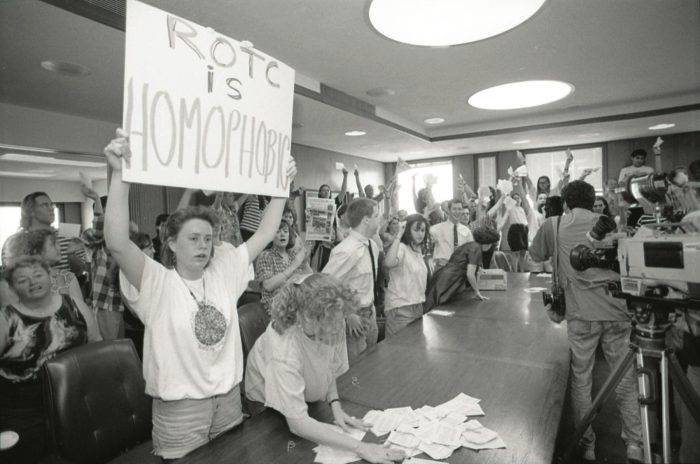Student Activism
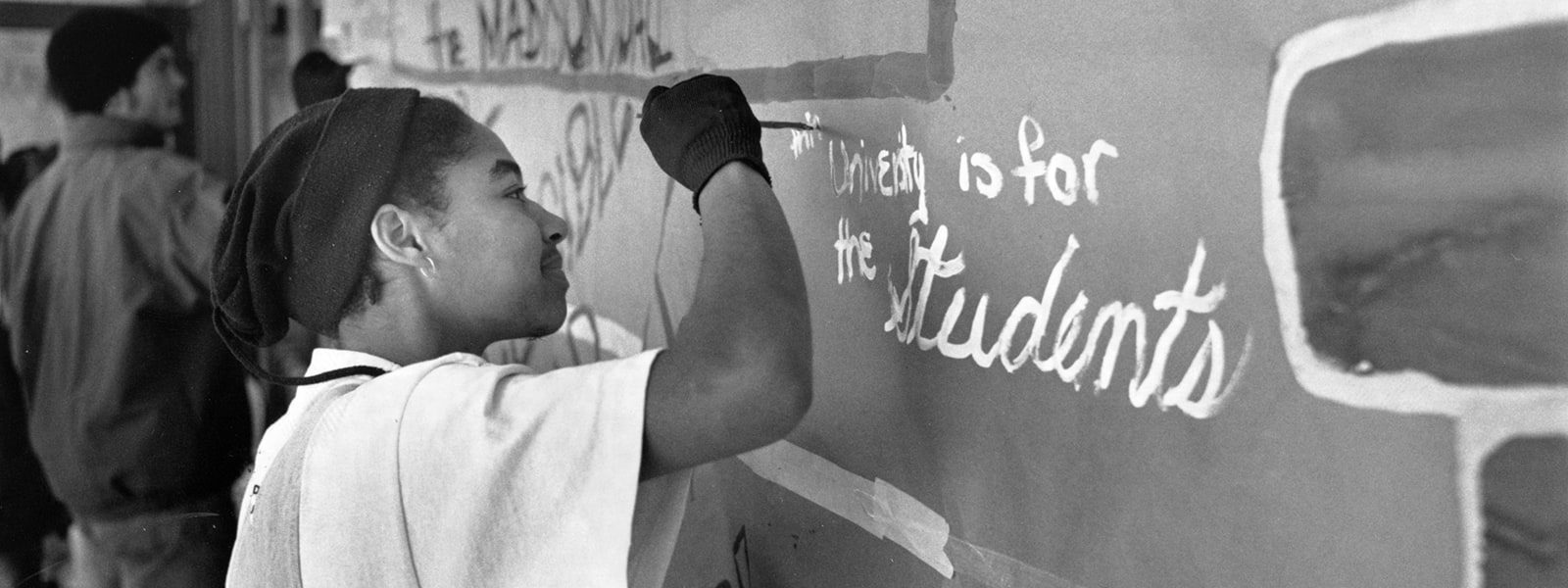
“I always tell people what I ended up studying was revolutionary studies. That wasn’t in the curriculum but that’s what I studied. That’s what I spent the majority of my time doing.”
UW–Madison has long had a reputation for having a civically minded student body. Though student organizing and protest started long before the turbulent 1960s, that era solidified UW–Madison’s image as a “protest school.” The variety of protests reveal a student body that is engaged in society’s most pressing problems. From local issues to international concerns, students have continued to make their voices heard.
Student activism at UW–Madison has birthed academic departments, increased university commitments to diversity and inclusion, and challenged various institutional forms of injustice. What becomes clear in studying the history of student activism at UW–Madison is this: the university changes because students demand change.
Student Organizing against UWPD
The Daily Cardinal opinion piece did not mince words: “Brash, Outdated Police Practices Need Action, Now.” By 1951 when the article ran, students, faculty, and staff had been raising concerns about the behavior of the University of Wisconsin–Madison Police Department (UWPD) for years. The list of improper conduct grew annually—throwing leaded billy clubs at students, disrupting class to arrest students, searching dormitories without warrants, threatening students with firearms, and improper “handling and methods of approach to student sex activity and homosexuality.”
When President E. B. Fred refused to act, the Student Board again launched their own investigation into the conduct of the UWPD. In May 1951, they passed a resolution urging a “re-evaluation of the philosophy of the department.” Less than 15 years after the UWPD was formed, the department was fully reorganized in 1952. This can be almost entirely credited to the organizing done by UW–Madison students, faculty, and staff.
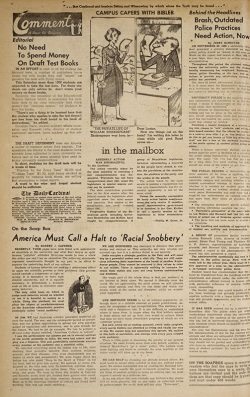
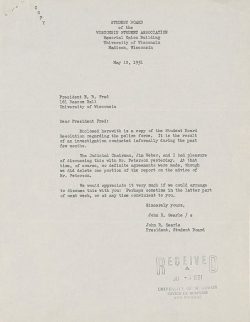
The Gay Purges
Between 1948 and 1962, UW–Madison administrators, police, and medical professionals regularly punished and expelled male students whom they believed to be gay. They labeled gay individuals as deviants, considering them to be a moral threat to the university. These systematic expulsions came to be known by the LGBTQ+ community as the “gay purges.”
The first purge began in 1948 when two men were found in an intimate position in a vehicle by Officer Joseph Hammersley of the University of Wisconsin–Madison Police Department (UWPD). Hammersley, along with Madison Police and Dane County authorities, led a months-long “morals investigation” of the Madison community. At least 12 men were arrested and charged. Among them were UW–Madison students, who also faced disciplinary action from the university, including expulsion.
By 1951, students, faculty, and staff had been raising concerns about the behavior of UWPD for years. The list of improper conduct grew annually—disrupting class to arrest students, searching dormitories without warrants, throwing leaded billy clubs, threatening students with firearms, and improper “handling and methods of approach to student sex activity and homosexuality.”
These purges continued through 1962. They severely altered the lives of the people who were targeted. Many gay students were forced to leave UW–Madison without their degrees, some only weeks from graduation. Others lost funding, teaching opportunities, and prestigious honors like Fulbright scholarships. While some tried to apply to other universities, their disciplinary records often followed them, making it nearly impossible to complete their education. Many were “outed” to their parents. The university also targeted faculty and staff, many of whom lost their jobs.
“One of my roommates, a gay man at the time … was contacted. And he flipped out. I mean he lost it. He was in the Art Department in the School of Education. And he simply left school of his own volition. That was one of the examples that was pretty close to home for me. He just didn’t know how to cope with it.”
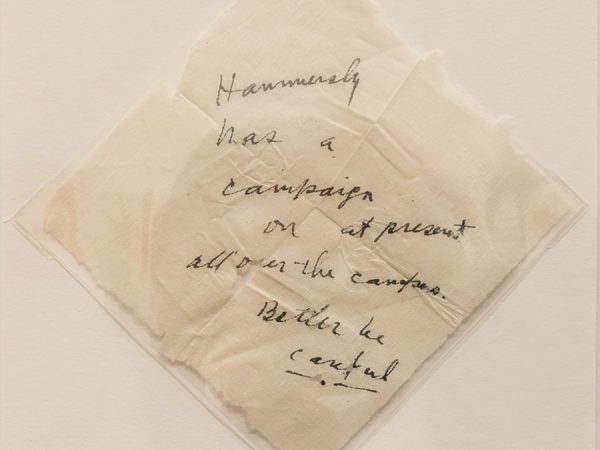
Toilet Paper Note
As the purges unfolded, many UW–Madison community members expressed their disdain for the practice. A 1948 anonymous opinion piece stated, “This witch hunt and this witch burning is an act of the most vicious bigotry.” This piece of toilet paper was discovered in a police report filed by Hammersley in 1950. A man wrote this note hoping to protect a fellow campus community member from being targeted. He unknowingly passed the note to Hammersley.
The 1964–65 Negro Census
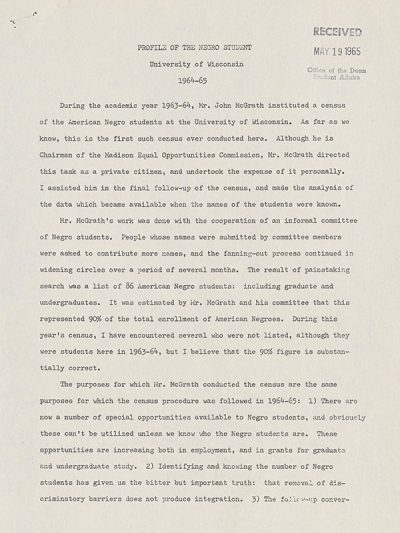
One of the university’s earliest attempts at a “campus climate survey” happened in 1964 and 1965. In an effort to “improve educational opportunities for Negro students,” the university took an informal census of Black students. The census was far from scientific or complete, with survey takers in some cases simply approaching Black students as they walked across campus, but the results were still revealing. The census found that Black students reported being the only Black students in their dormitories and classrooms. Almost all of the students reported being the only Black person their white peers had ever met. Black students reported feeling homesick and commented on their struggle to find community amid the segregated social life of the university.
Pre-1969 Black Student Strike Organizing
“The Black student, when you come to this university, you are reminded totally and totally again that this is a white man’s school. … Today, for the first time as a Black student, I found out what I wanted to do … I’m going to work with my people and if you kill me, I’ll give my life.”
As early as 1966, Black students at UW–Madison began organizing for change. A small group of student activists under the name Black People’s Alliance regularly met in the Rathskeller at Memorial Union in what they called the “colored people corner,” or the “CP corner”—a favorite gathering spot for Black students.
The first major organizing opportunity came following the death of Martin Luther King Jr. in April 1968. The scheduled memorial for King was originally planned by the university administration. Students fought to have control over the memorial. They wanted to use it as a platform for an open dialogue about the racism that Black students faced on campus. As the country reeled following King’s assassination, students continued to push the campus community to seriously reckon with racial discrimination.
In fall 1968, Black students at the University of Wisconsin–Oshkosh went on strike to demand equal rights on campus. Every Black student was expelled. In response, Black students at UW–Madison prepared for a strike of their own.
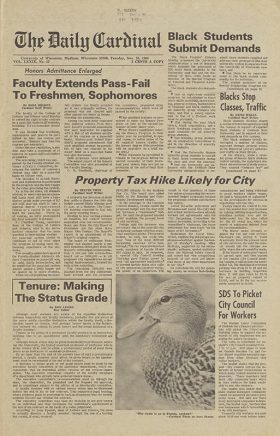
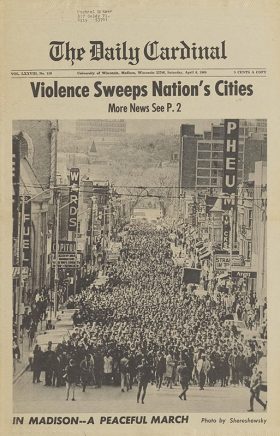
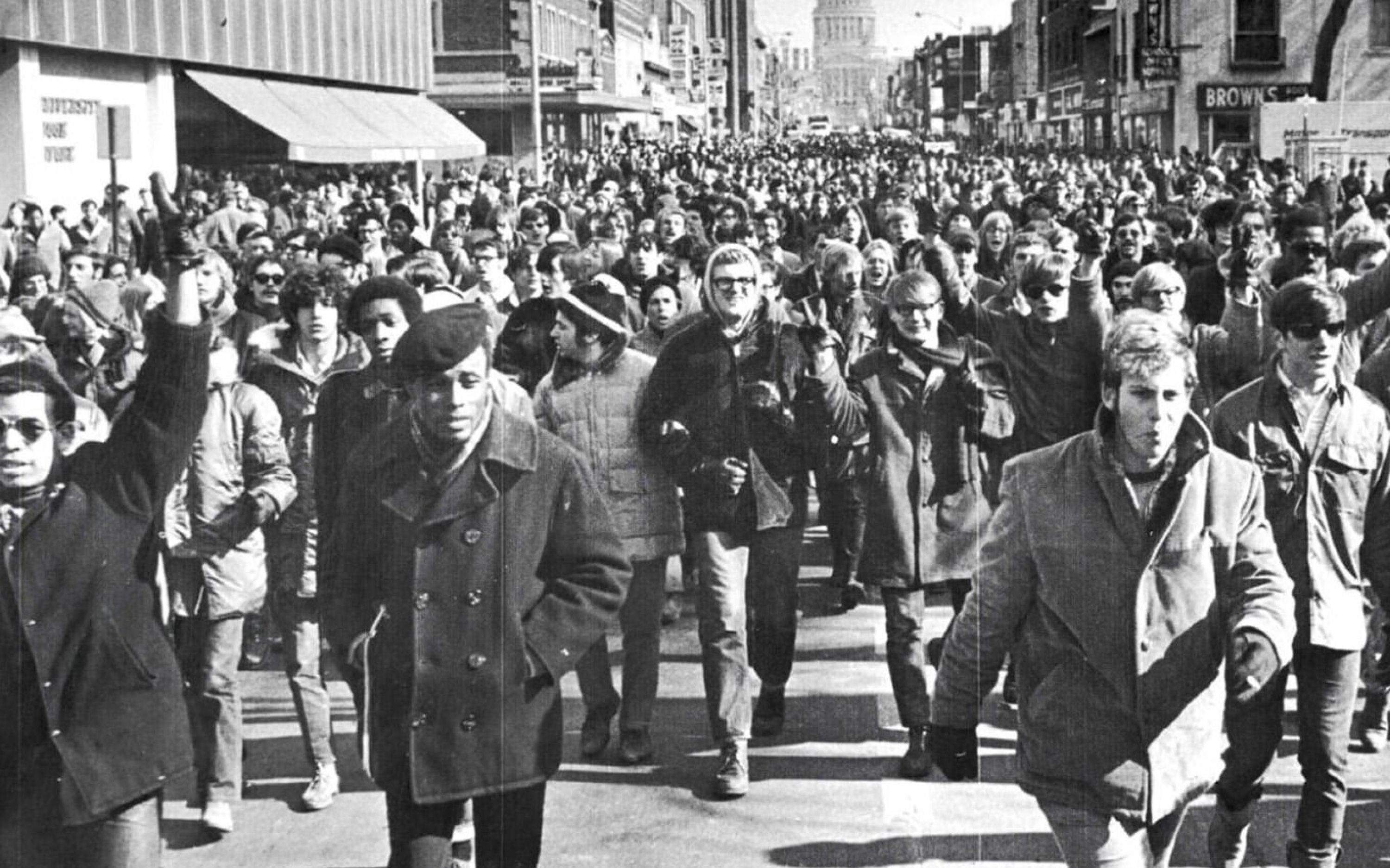
The Needs of Black Students are the Needs of the University
“I felt the only power we had was the power to disrupt.”
On the morning of February 7, 1969, a group of Black students delivered a list of 13 demands to UW–Madison Chancellor Edwin Young. If their demands were not met, they threatened to strike and keep the university closed by “disruption or destruction.” The morning of February 10 was cold. But that didn’t stop around 1,500 students from gathering across campus to support the strike. What would later be called the Black Student Strike had begun. It would end weeks later after a protracted fight between students, police, and university administrators.
After years of organizing for change through the “proper channels” of university administration, students felt they had no choice but to demand change. Their demands included the creation of a Black studies department, a campus social center for Black students, increased Black student enrollment, scholarships for Black students, and offers of admission to all of the expelled UW–Oshkosh students. The strike garnered the support of many students, faculty, and staff. In an effort to help educate students on Black history and culture, Black students led workshops and teach-ins and brought guest lecturers to campus. After relentless protesting, the university agreed to meet three of their 13 demands. Only the result of two demands—the Department of Afro-American Studies and the Black Cultural Center—are still present at the university.
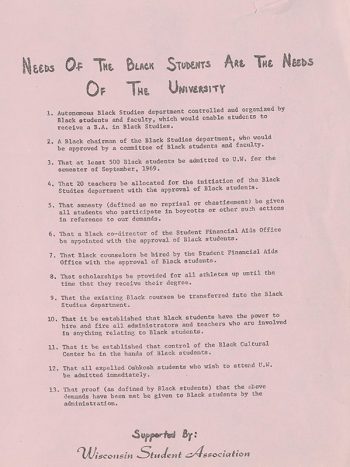
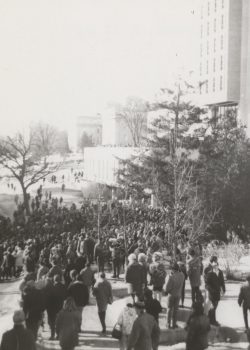
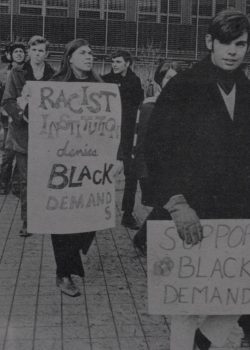
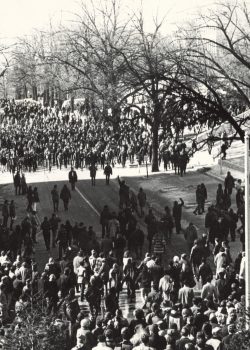
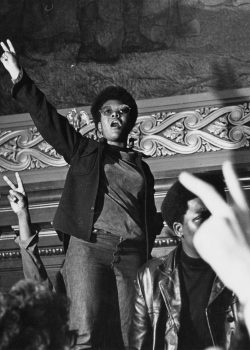
Although the Black Student Strike is celebrated by the university today, at the time it was heavily critiqued by administrators, alumni, and Madison residents. Some in the campus community viewed the actions of the strike leaders as frivolous, militant, and destructive. Many prominent campus members urged the university to reject the student demands. Many of the strikers faced serious consequences. All were vilified and mocked in the press. Some were forced to withdraw from school, while others lost scholarships, faced criminal charges, or worried for their safety and quickly left campus. The price of change was steep.
The 1969 Black Student Strike continues to serve as an example of how students are often on the front lines of change. The university’s hesitancy to implement and sustain their demands serves as a reminder that the work is not yet finished.
The 1969 Black Student Strike was divisive. While many students, faculty, and staff supported the students on strike, many others did not. Chancellor Edwin Young and other university administrators were bombarded with letters. They demonstrated the various viewpoints held at the time.
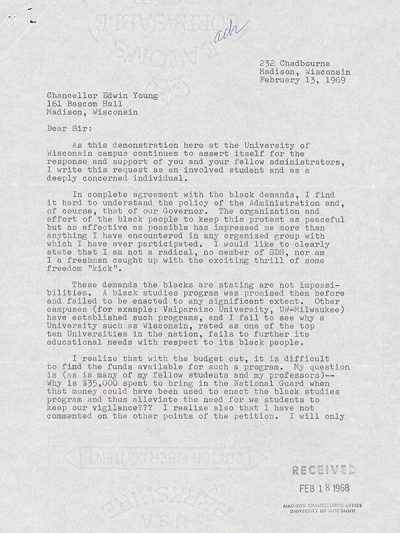
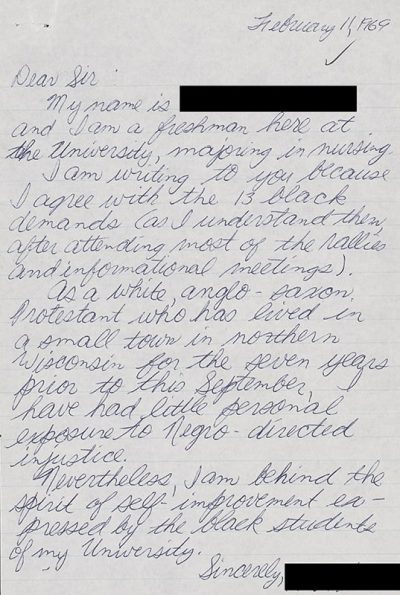
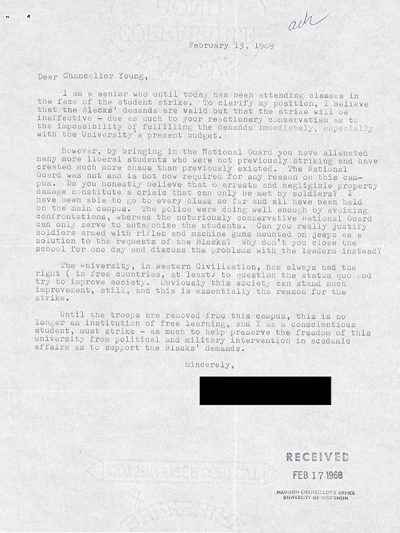
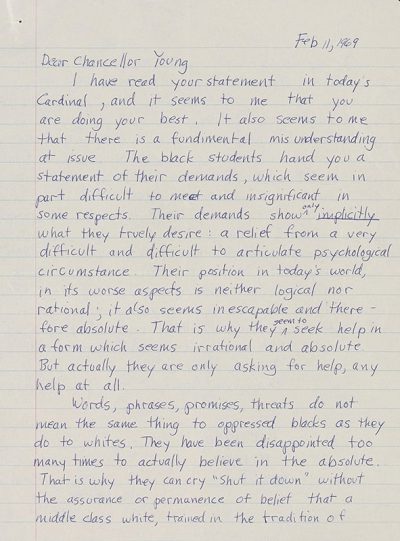
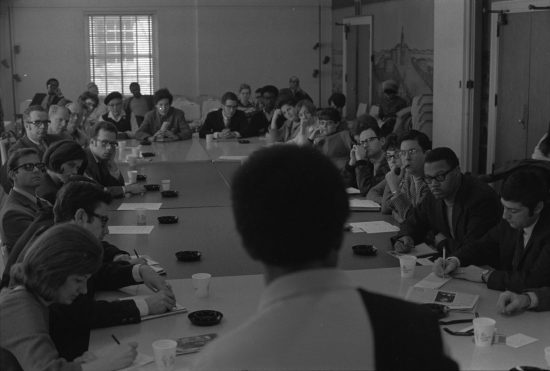
Black Student Conference
The week before the 1969 Black Student Strike, students of the Wisconsin Union Forum Committee planned and presented a weeklong conference called “The Black Revolution: To What Ends?” The conference helped campus learn about the Black Revolution as a national movement, provided opportunities for Black students to meet Black leaders, focused campus attention on racial issues and university responses to issues, mobilized university resources to address current racial problems, and discussed the role of white people in the movement and coalition building.
There were an estimated 16,685 people in attendance, consisting of UW–Madison students, faculty, and staff; visiting professors; Madison community members; and guest speakers, poets, and performers. The conference hosted lectures, panel discussions, student-led workshops, film showings, dinners, poetry and literary readings, and art exhibits. Notably, Gwendolyn Brooks performed a poetry reading and Jesse Jackson gave a speech. The conference is often noted as giving momentum to the Black Student Strike.
Angela Davis on Campus
On November 6, 1972, Angela Davis spoke at the UW Shell to a crowd of 25,000 as a part of the Afro-American Community Service Center’s lecture and film series, “A Real Look at America, From the Bottom.” Davis spoke on an array of issues from capitalism to women’s liberation to freeing political prisoners, saying, “Racism has become increasingly a tool of the capitalist to reap extra profits.” Davis incidentally came to the UW to speak after a 19-year-old student, David Scott, was fatally shot by a white Madison resident. While visiting, Davis urged UW students and community members to build a movement around the David Scott case. In 2019, Davis revisited campus and spoke about the importance of young people in making change, saying, “It is in the interest of younger people to generate hope for the future, for our collective future.”
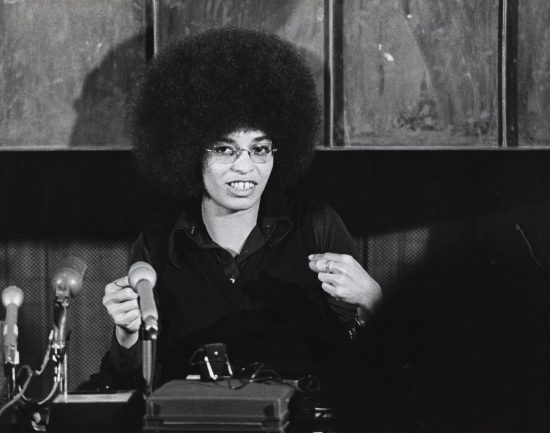
The Beat Goes On …
In October 1968, the Afro-American Race Relations Center opened. The center served as a place for Black students to participate in intellectual and social programming—like lecture series, theatrical productions, and exhibitions. The center also sponsored several public-facing events, including a Black Arts Festival. Further, the center sought to provide neglected basic services to the local Black community, such as clothing and food drives, job and housing referrals, and, if necessary, bail bonds.
Chancellor William Sewell hoped opening the center would appease Black students who had been organizing and agitating for change on campus. Seeing the success of the center, Native and Chicanx students demanded that the university create centers representing them. Native students were given a center, while Latinx students worked on a proposal for their space. Unwilling to invest in the operations of three centers simultaneously, university officials began to pivot their stance on race relations centers. In 1973, Dean of Students Paul Ginsberg announced the closing of all campus ethnic centers. He alleged that their existence was counter to the university’s “academic mission” and promoted separatism.
“We are asking that the enormous resources of this great university be used not just to ‘study’ us but also to help us. We are asking that we be included in the official academic mission not just as ‘bright individuals’ who made it in spite of the odds but as citizens of this state who have been excluded for decades. We want to be allowed to do some ‘sifting and winnowing’ without being accused of being ‘racist in reverse’ or practicing ‘reverse discrimination.’”
In an alternative approach, the university relocated funds to support three positions in the Dean of Students Office that would be dedicated to working with students of color. Many students, faculty, and staff were unhappy with the decision. To them, closing the centers represented a reluctance of university administrators to dedicate time, space, and funds to students of color. Protests ensued. Students clashed with campus police, including officers yelling racist insults at students. The Open Centers Committee—a group of student activists—began to occupy center spaces 24 hours a day. As protests grew in numbers and intensity, the university looked for ways to placate students of color without reinstating the centers. In 1974, the Open Centers Committee offered to cease its protest if the university agreed to commit to multicultural programming. The university agreed. The centers were closed in 1974.
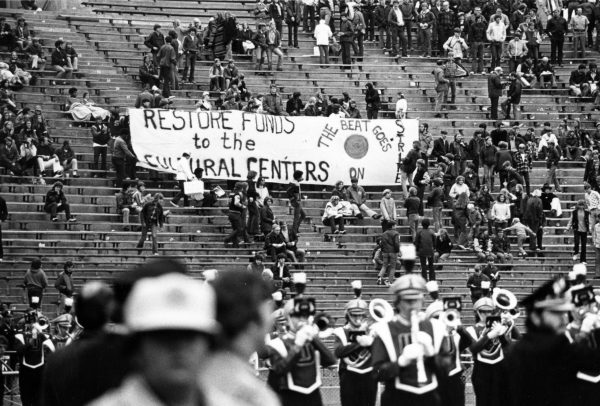
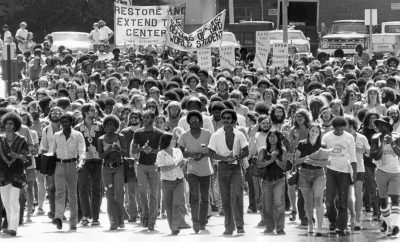
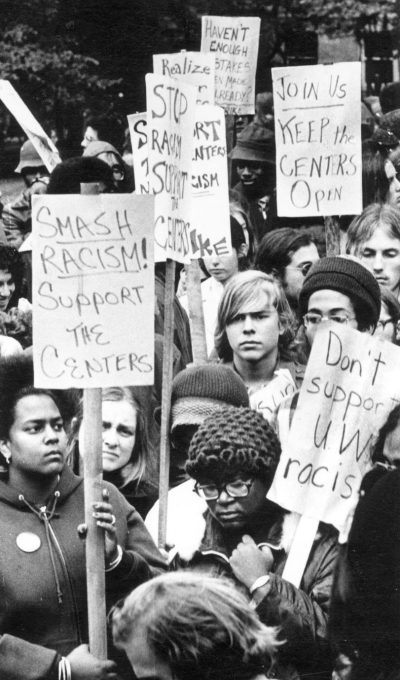
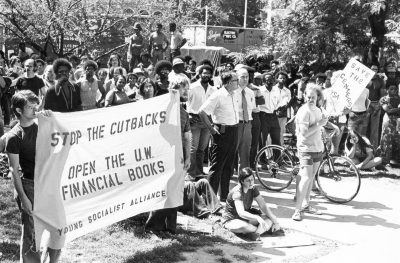
A Culture of Racism
Numerous racist events plagued the UW–Madison campus in the late 1980s. These made national headlines and spurred demands for dramatic action to change the culture of the university. In spring 1986, the Kappa Sigma fraternity hosted a party with a “Harlem Room” featuring white students dressed in blackface, watermelon punch, fried chicken, a basketball hoop, and a boom box. To celebrate its annual Fiji Islander party in 1987, Phi Gamma Delta erected a racist statue on its lawn depicting a caricature of a person of color. In spring 1988, the Zeta Beta Tau fraternity became the center of controversy after it hosted a “slave auction” party in which some participants dressed in blackface impersonating famous individuals such as Oprah Winfrey. Also in spring 1988, the University of Illinois’s chapter of Acacia fraternity visited UW–Madison at the invitation of the local chapter. During the visit, members disrupted five classes, including two African language and literature courses, by shouting, lighting stink bombs, and provoking altercations with students. After each of these incidents, students of color responded with demands for a change in the culture at UW–Madison.
In response university administrators created the first ever diversity plan at UW–Madison—the Madison Plan. After implementation, discrimination and racist activities and events continued to occur. Without evidence of how the plan bettered the lives of marginalized students, faculty, and staff, many were hesitant to view the initiative as successful. Subsequent institutional diversity plans have faced similar scrutiny, and many of the issues that inspired the Madison Plan continue to affect campus.
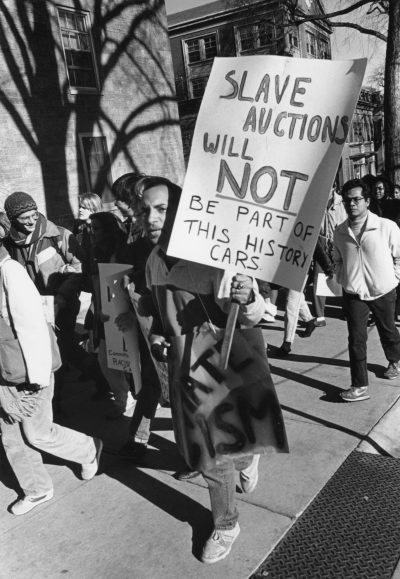
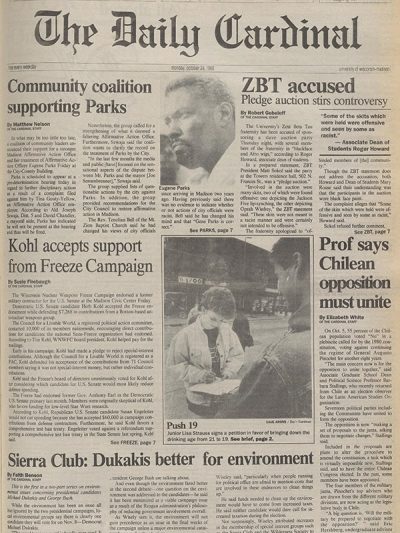
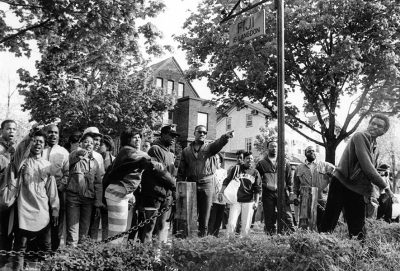
The Steering Committee on Minority Affairs
In 1987, students, faculty, and staff formed the Steering Committee on Minority Affairs. They hoped to formally urge university administrators to enact changes to combat rampant racism and discrimination on campus. The committee published the Final Report of the Steering Committee on Minority Affairs in November 1987. It was nicknamed the “Holley Report” after student member and co-president of the Wisconsin Black Student Union Charles Holley. The report stated that the UW’s previous attempts at addressing discrimination and diversity were ineffectual. They proposed nine changes to address racial and ethnic disparities. Among those recommendations were the appointment of a vice chancellor of minority affairs, establishment of a multicultural center, requirement of six credits of ethnic studies for all students, and the development of a relationship between the university and Madison’s communities of color.
Newly appointed Chancellor Donna Shalala heavily criticized the report, calling it “separatist” in nature and arguing that its recommendations would not sustain lasting change at the university. In February 1988, less than one month after she began as chancellor, Shalala side-stepped the recommendations of the Steering Committee on Minority Affairs. Instead, she released her own plan, the Madison Plan, which became the university’s first formal diversity plan. Discrimination and racist activities and events continued to occur. Without evidence of how the plan bettered the lives of marginalized students, faculty, and staff, many were hesitant to view the initiative as successful. Subsequent institutional diversity plans have faced similar scrutiny, and many of the issues that inspired the Madison Plan continue to affect campus.
In November 1988, students from the Minority Coalition sent a list of demands to Chancellor Donna Shalala to address instances of racism and sexism on campus. Download and read the Minority Coalition’s 10-point plan of action (PDF).
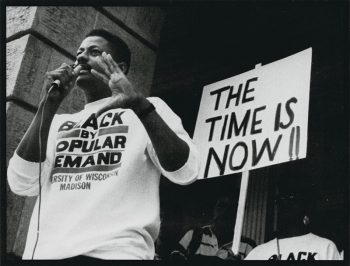
The Multicultural Student Center
“During this time of turmoil ... students were upset. They needed a place where they could vent and discuss issues.”
The report from the student-led Steering Committee on Minority Affairs, also known as the “Holley Report,” was largely rejected by Chancellor Donna Shalala in favor of the Madison Plan. One of its lasting contributions, however, is the Multicultural Student Center. Established in fall 1988, the center was opened to support academic achievement, foster better relationships across campus, and create a sense of identity and belonging among students of color. Under the direction of Candace McDowell, the “interim” Multicultural Student Center was given inadequate space on the second floor of Memorial Union. McDowell referred to it as “interim”— on letterhead, on signage, in conversations—as a reminder to the university “that this temporary space is not what was promised.” Ten years later, the Multicultural Student Center was moved to the Red Gym. Today, funding and space allocation continue to be a challenge. Yet, the center continues to be a crucial space for marginalized students to find community.
1992 Gender and Sexuality Campus Center
The Lesbian, Gay, and Bisexual Campus Center was founded by Alnisa Allgood using funding from segregated fees to circumvent the Board of Regents, which was unsupportive of the effort. In 2018, the name was changed to the Gender and Sexuality Campus Center. The center was initially housed off campus at the Capital Center, later moving to Memorial Union, before finally settling in at the Red Gym, where it is still located today.2009 American Indian Student & Cultural Center
The American Indian Student & Cultural Center (AISCC) was founded as a space for Native student groups, academic services, and cultural events. The AISCC houses student-run organizations: Wunk Sheek, Ojibwe language group, Wunk Sheek Drum, Alpha Pi Omega Sorority, and the American Indian Science and Engineering Society. American Indian Studies faculty as well as satellite advising services (American Indian Student Academic Services, the PEOPLE Program, American Indian Curriculum Services, the Cross College Advising Service, and the Office of Undergraduate Recruitment and Retention) make use of the space.2017 Black Cultural Center
The Black Cultural Center was founded to serve Black students by facilitating opportunities for academic and social support, co-curricular programming, and community building. The center descends from the lineage of the Afro-American and Race Relations Center as a space to support Black students.2018 Latinx Cultural Center and the Asian Pacific Islander Desi American Student Center
In response to intensive student organizing efforts, the Latinx Cultural Center and the Asian Pacific Islander Desi American Student Center were established as “start-up spaces” to serve the academic, social, and cultural needs of these student populations.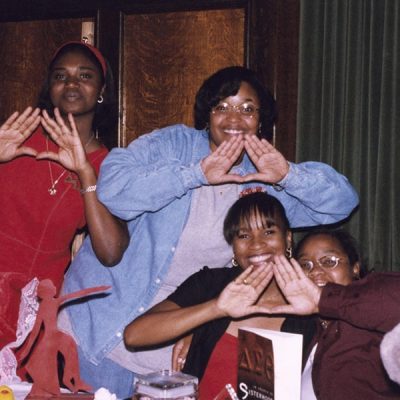
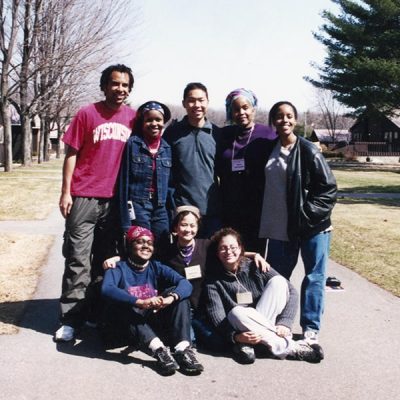
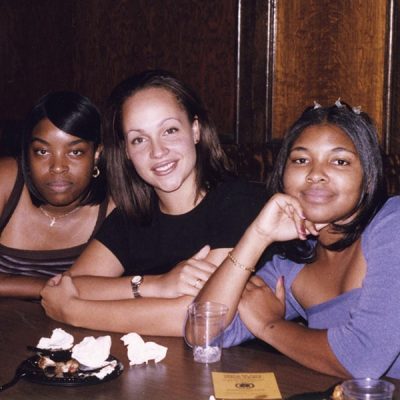
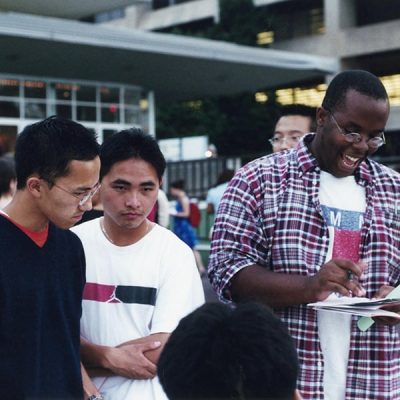
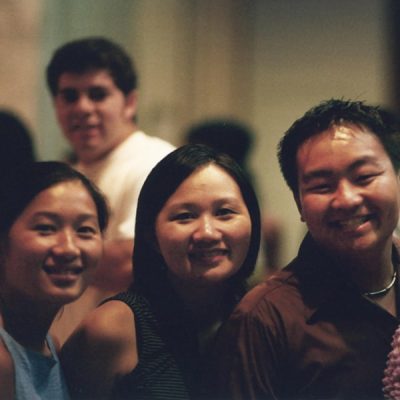
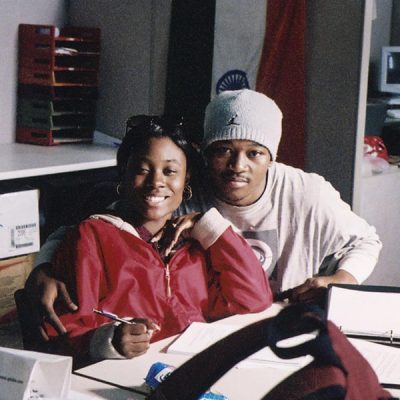
Student Protest
The history of student protest at UW–Madison reveals a civically engaged student body concerned with some of society’s most pressing issues. Their enthusiasm and energy for change often focused on the campus community but also expanded far beyond the borders of Madison. Students organized and protested against the United States government’s foreign policy in Vietnam, Iran, and Central America; against apartheid in South Africa; and in support of labor unions.
In May 1968, students from the Concerned Black People (CBP) group and University Community Action Party (UCA) called on the university to sell its shares of Chase Manhattan Investments (valued at $230,000) because of its support for South African apartheid policy. The Board of Regents resolutely declined to sell its Chase Manhattan Bank stock. Students held a rally on Bascom Hill to protest this refusal and continued to protest against apartheid. In late February 1985, anti-apartheid protests led to the cancellation of a talk by South African lecturer Pieter Claasen from Stellenbosch University in South Africa. In early April 1986, students took part in anti-apartheid demonstrations, including building a shantytown at the capitol building.
Throughout the 1970s, students turned their attention toward the United States government’s foreign policy. On September 13, 1973, 400 students demonstrated against U.S. involvement in the military coup in Chile. On November 17, 1978, around 200 students, many of whom were Iranian, protested against the Shah and U.S. involvement in Iran. On November 16, 1979, the Madison Committee Against the Backlash (MCOB), which supported the Iranian anti-Shah students who took over the American embassy in Tehran and held American diplomats hostage, held a rally. The rally had 600-plus attendees consisting of MCOB supporters and counter anti-Iranian protesters.
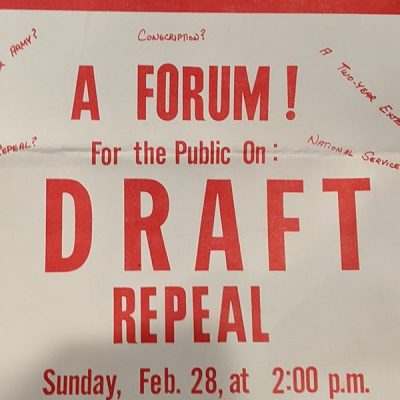
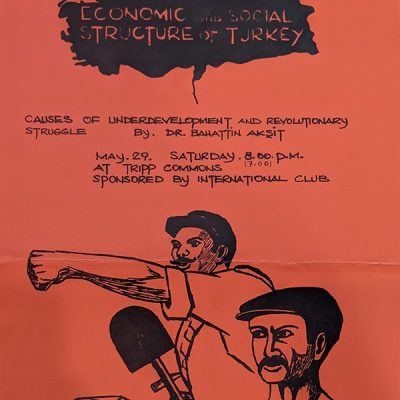
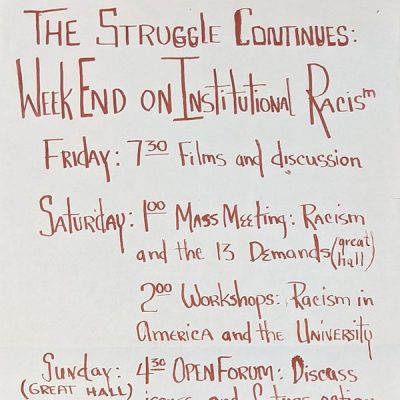
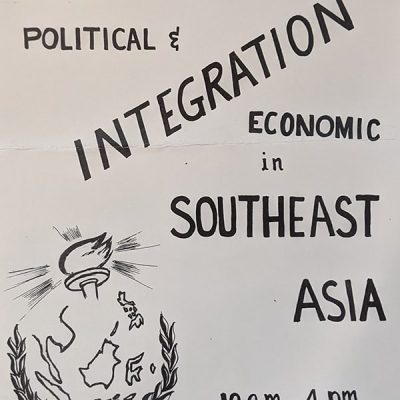
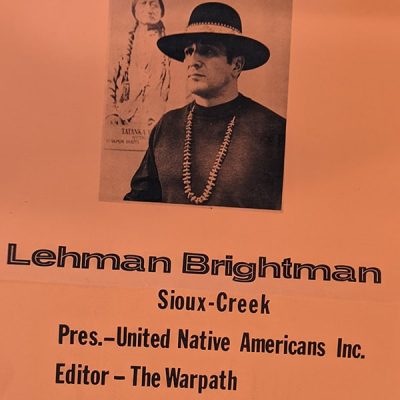
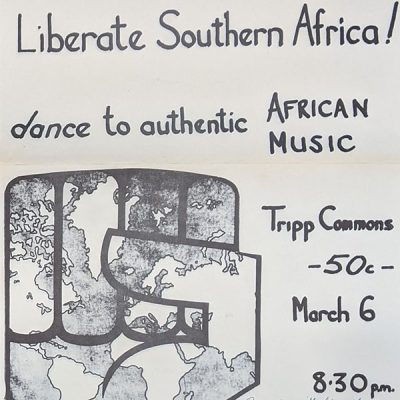
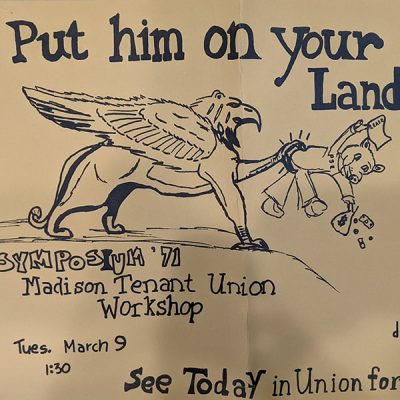
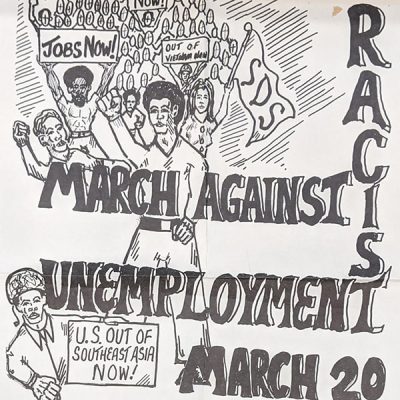
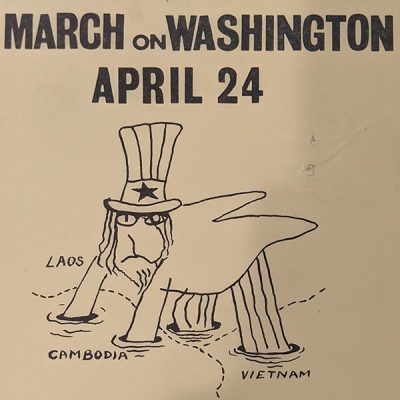
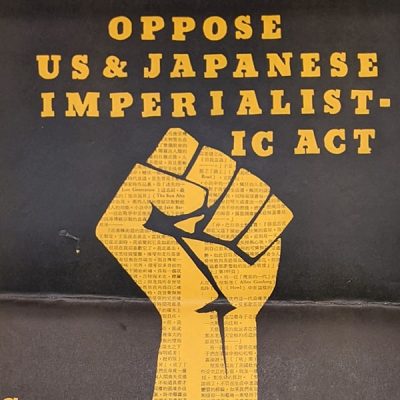
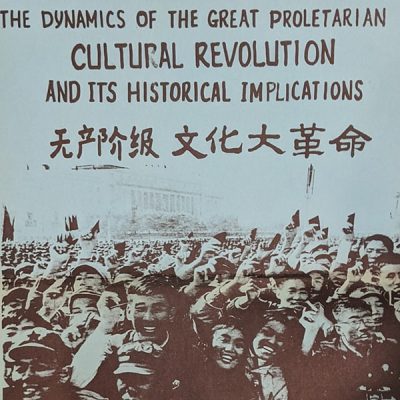
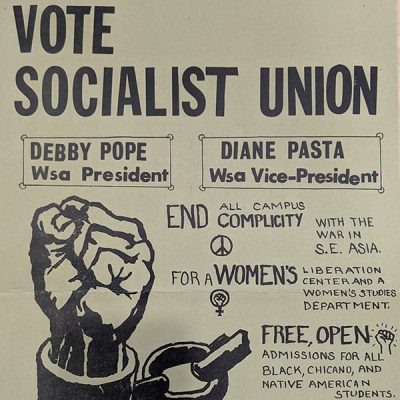
No Hate in the Dairy State
Wisconsin began a nationwide movement against the Department of Defense’s policy that barred gay people from military service. In 1985, student Richard Villasenor started organizing others to force the Reserve Officers’ Training Corps (ROTC) to abide by the 1982 Wisconsin state gay rights bill and the university antidiscrimination policy. He inspired and worked with faculty members, including professors Joe Elder, Michael Olneck, Claudia Card, James Steakley, and others, who formed a group called Faculty against Discrimination in University Programs. In 1989, UW–Madison faculty voted in favor of the rights of lesbian and gay service members and against the military policy. They urged UW–Madison administrators and the Board of Regents to remove the ROTC from campus.
Following the vote, in April 1990, students crowded around Chancellor Donna Shalala’s office demanding the expulsion of the ROTC from UW–Madison’s campus. The chant “no hate in the dairy state” echoed through Bascom Hall. This protest was the culmination of years of activism on the part of students and faculty. They argued that the military’s exclusion of gay and lesbian service members contradicted laws against discrimination in the state of Wisconsin as well as the university’s own commitment to diversity and equality. While Shalala and most members of the Board of Regents opposed the military’s policy, they insisted on maintaining the university’s ROTC programs. This stemmed largely from concerns that the university could lose federal funding if the ROTC’s contract with the university was canceled. While UW–Madison officials publicly espoused a commitment to ending discrimination on campus, they ultimately prioritized financial considerations over protecting the rights of gay students.
UW–Madison student and faculty organizers were on the forefront of the movement to combat the military’s homophobic policies on college campuses. By 1991, more than 60 schools across the nation engaged in similar grassroots efforts, molded around the steps that UW–Madison students and faculty took to highlight the issue.
#TheRealUW
In 2016 senior Denzel McDonald, also known as King Shabazz, protested racism and discrimination through graffiti. His message on the outside of the George L. Mosse Humanities Building read, “Racism is in the air. Don’t breathe.” UWPD officers interrupted Professor Johanna Almiron’s Afro-American studies class to arrest Shabazz in front of his peers and against objections from Almiron. Shabazz’s arrest galvanized students to protest on his behalf. Student activists called on Chancellor Rebecca Blank to allow Shabazz to complete his degree. Students also wanted UWPD to drop the charges against him and asked for all officers involved to resign. Chancellor Blank declined to take action. UWPD refused to acknowledge the arrest as unjust.
Shabazz’s arrest sparked what came to be known as #TheRealUW campaign. Students were already sharing their individual experiences of racial discrimination, harassment, and hostility using #TheRealUW hashtag on social media. But Shabazz’s arrest resulted in an increased use of the hashtag and brought new attention to the stories being shared. Though each story was unique, the common thread was a fear of violence, isolation, and invisibility that students of color felt on UW–Madison’s predominately white campus. #TheRealUW campaign demanded that the concerns of students of color be taken seriously and gave unprecedented attention to their experiences at UW–Madison.
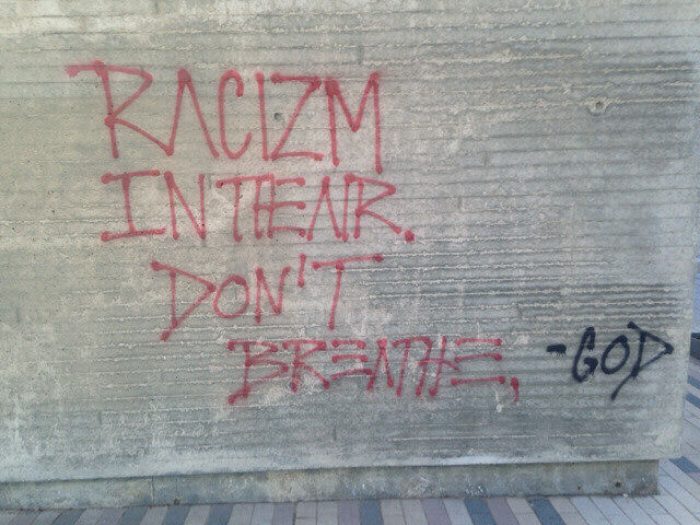
Recent Incidents
Recent campus incidents continue to highlight students’ claims of feeling discriminated against based on their identities. In 2017, the Dejope Fire Circle was defaced with “Columbus Rules 1492.” In 2020, anti-Asian graffiti littered campus at the start of the COVID-19 global pandemic. Many incidents have made marginalized students feel unwelcome and unsafe.
“I have had many friends that have been harassed by drunk white males. They have been called the ‘N word’ or have been told they don’t belong on this campus. As a student of color, I no longer attend parties due to the constant feeling of being harassed. However, it is something that is impossible to escape on this campus.”
“Students who ask to touch my hair, students who touch/pull my hair without asking, probing questions about how my hair works and if it’s real.”
“Always asked about where I’m from, get remarks and threats made at me because of being Mexican, had people make fun of me right in front of me because I’m Mexican, been asked if I’m an illegal immigrant or if anyone in my family is, have been told that I’m going to be deported.”
“It can be overwhelming when I am walking home at night and there are large groups of drunk students walking past me. … I have been verbally assaulted and called a n**** and b**** before, so I try to avoid this happening again by simply not leaving my home.”
Chamberlin Rock
“Some will tell you that a rock is just a rock. That to fear harm from an inanimate object is prescientific, irrational. But to be human is to imbue objects with meaning. It’s why we offer flowers when we mourn or love, why people carry lucky charms, and why people unknowingly begin to whisper when they approach the U.S. Constitution in the National Archives. To be sure, the rock is an innocent object, in which we invest meaning. This is a conversation about its symbolic associations, which have intense meaning to some and no meaning to others. When we made the decision to move the rock, we listened to those who saw a legacy of racism and present-day pain where others saw a mere rock.”
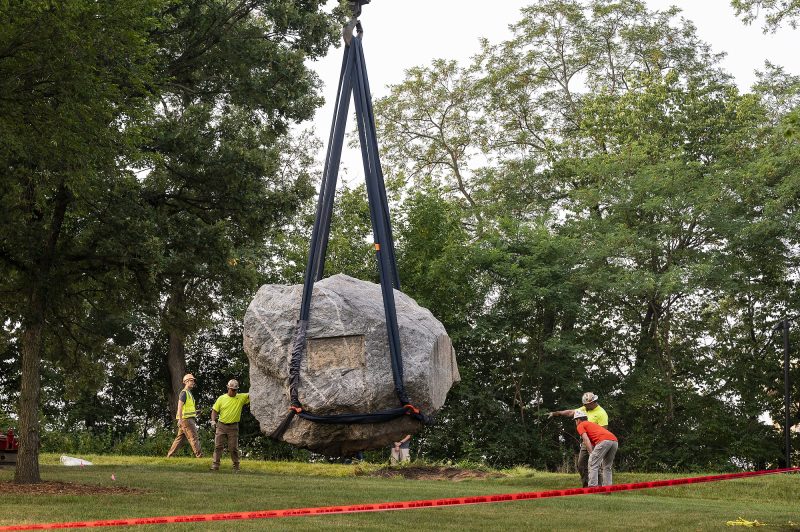
“I see this as offering the next generation of students something to build off of. ... We hope this movement and this momentum carries on.”
In the 1920s, before being renamed Chamberlin Rock, a 42-ton boulder on campus was referred to by a harmful nickname that included a racial slur. Where others saw just a rock, Black and Indigenous students at UW–Madison saw a painful reminder of racism. Student activists from the Black Student Union and Wunk Sheek began organizing to “make a more inclusive environment for Black students” by removing the rock. Over the course of a year, they worked with university administrators, staff, and members of the campus community to extract it from Observatory Hill. On the morning of August 6, 2021, the university removed the rock from campus as student organizers watched.
Our Shared Future
The Our Shared Future initiative was founded in 2018 by a group of committed faculty and staff. Our Shared Future is a collective act of education. It began with a heritage marker, now installed outside South Hall, that acknowledges the historical and current relationship between the Ho-Chunk peoples, UW–Madison, and the United States.
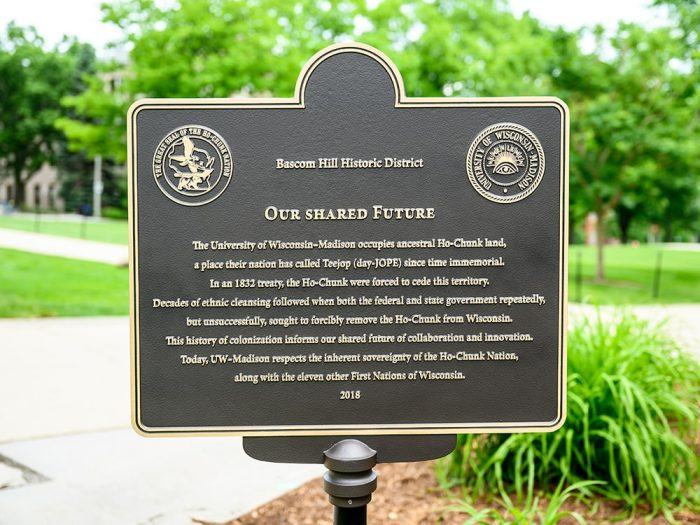
But Our Shared Future is more than a heritage marker. It represents UW–Madison’s commitment to respect the inherent sovereignty of the Ho-Chunk Nation and the other First Nations of Wisconsin. It calls on each of us—faculty, staff, and students—to deeply consider our shared past and present with Indigenous peoples in this place, Teejop, and to make our own personal and institutional commitments to achieve a shared future with them.
Our Shared Future is a process. It is a collective act of moving together from ignorance to awareness; an educational framework for posing questions; and an opportunity to celebrate Ho-Chunk people, as well as learn about the hard truths of our histories with them. It asks our campus community to reflect deeply on our collective history and present with Indigenous peoples and to make personal and institutional commitments to achieve a better future together.
Sources
- Rashad, Liberty. Interview by UW–Madison–Madison Communications. 2018, in Madison, Wisconsin, transcript, UW–Madison Archives, UW–Madison Libraries, Madison, WI.
- “A Brief History of UW–Madison Student Activism.” Go Big Read: University of Wisconsin–Madison, Last modified May 14, 2020.
- Kennedy, Tyler and David Null. “Protests & Social Action at UW–Madison during the 20th Century.” University of Wisconsin–Madison Libraries.
- Letter from John Seale, President of Student Board, to President E.B. Fred, 10 May 1951, Box 289, “Buildings and Grounds University Police” Folder, VP of Business and Finance Records, General Correspondence Files, UW–Madison Archives, UW–Madison Libraries.
- Wagner, Richard. We’ve Been Here All Along Wisconsin’s Early Gay History. Madison, WI: Wisconsin Historical Society Press, 2019.
- Gerard, Ezra. “Gay Purge: The Persecution of Homosexual Students at the University of Wisconsin–Madison, 1962–1963.” UW–Madison Public History Project (blog), March 22, 2021.
- “Two Plead Not Guilty To Sodomy Here.” Capital Times (Madison, WI), June 9, 1948, UW–Madison Archives, UW–Madison Libraries.
- “Eight More Men Taken to Court As Police Push Morals Probe.” Capital Times (Madison, WI), June 12, 1948. UW–Madison Archives, UW–Madison Libraries.
- Newspaper Clipping, “Brash, Outdated Police Practices Need Action, Now.” Daily Cardinal, May 23, 1951, Dean of Men’s Records – Kenneth Little, Box 28 “Campus Police Problems” Folder, UW–Madison Archives, UW–Madison Libraries.
- CSCA Minutes, 17 April 1962, Box 1, “Homosexual Problem” Folder, Dean of Students – LGBT Historical Liaison, 1968–2010 Files, UW–Madison Archives, UW–Madison Libraries.
- Bosworth, Lewis. “Oral History Interview: Lewis Bosworth.” Interview by Scott Seyforth. 07 April 2009. OH #0940, UW–Madison Oral History Project, UW–Madison Archives, UW–Madison Libraries.
- “Voice of the People.” Capital Times (Madison, WI), June 1948, UW–Madison Archives, UW–Madison Libraries.
- Doyle, Ruth. “Profile of the Negro Student, University of Wisconsin, 1964–65,” Box 8, “Negro Students, Census Of” Folder, Dean of Student Affairs, Lewis E. Drake subject files “Mim-Public Relations,” UW–Madison Archives, UW–Madison Libraries.
- For more on the speeches given by Black students at the memorial: Kaufman, Casey Davis. “Dr. Martin Luther King Memorial rally, Bascom Hill, UW–Madison, April 5, 1968.” American Archive (blog), January 17, 2014.
- Casanova, Stephen. “The Ethnic Studies Movement: The Case of the University of Wisconsin Madison.” Ph.D. dissertation, University of Wisconsin–Madison, 2001.
- Gordon, Rob. “Thousands Line Bascom to Mourn Death of King.” Daily Cardinal (Madison, WI), April 6, 1968, UW–Madison Archives, UW–Madison Libraries.
- Steinzor, Rena. “Blacks and Whites.” Daily Cardinal (Madison, WI), Apr. 8, 1969, UW–Madison Archives, UW–Madison Libraries.
- “Oshkosh.” Oshkosh Northwestern (Oshkosh, WI) Dec. 28, 1968.
- Wells, Gene. “Blacks Stop Classes, Traffic.” Daily Cardinal (Madison, WI), Nov. 26, 1968, UW–Madison Archives, UW–Madison Libraries.
- Rashad, Wahid. “Oral History Interview with Wahid Rashad,” interview by University of Wisconsin–Madison Communications in 2018, in Madison, WI. Transcript. UW–Madison Archives, UW–Madison Libraries.
- Greenberg, Peter, Ron Legro, and Judy Shockley.“Blacks Demand Reform, Students Stop Classes.” Daily Cardinal (Madison, WI), Feb. 8, 1969., UW–Madison Archives, UW–Madison Libraries.
- Gilbert, Cornelius K. “Their Time & Their Legacy: African American Activism in the Black Campus Movement at the University of Wisconsin-Madison and its Enduring Impulse.” Ph.D. dissertation, University of Wisconsin–Madison, 2011.
- Gondek, Mike and Len Fleischer.“Students Strike Class, March.” Daily Cardinal (Madison, WI) Feb. 11, 1969.
- “Thirteen Needs Explained,” Box 13, Folder 1, Afro-American & Race Relations Files, UW–Madison Archives, UW–Madison Libraries.
- Greene, Tim. “Black Faculty Backs Demands.” Daily Cardinal (Madison, WI), Feb. 12, 1969, UW–Madison Archives, UW–Madison Libraries.
- “Madison Campus Student Suspension & Expulsion Cases – Jan. 1969 to Feb. 1970,” Box 4, “Committee on Student Conduct Appeals & Student Conduct Hearings, 1968-1969” Folder, Chancellor’s Office Records – 1964–71 – Edwin Young Files, UW–Madison Archives, UW–Madison Libraries.
- Levitan, Stuart D. Madison in The Sixties. Madison, WI: Wisconsin Historical Society Press, 2018.
- Black Demands Report – Appendix F: “Union Forum Committee Report,” Box 1 Folder 3, The Black Voice Collection, UW–Madison Archives, UW–Madison Libraries.
- Pettis, Patricia and Denise Quarles. “The Angela Davis Madison Visit.” The Black Voice, November 22, 1972.
- “New Center to Encourage Afro-American Programs.” Daily Cardinal (Madison, WI), Nov. 8, 1968, UW–Madison Archives, UW–Madison Libraries.
- Goetz, Susan. “New Afro-American Center Advises, Assists Students.” Daily Cardinal (Madison, WI) Nov. 1, 1968, UW–Madison Archives, UW–Madison Libraries.
- Gribble, Roger. “Afro-Center Status Getting Reassessed.” Wisconsin State Journal (Madison, WI), Mar. 17, 1973.
- Ginsberg, Paul. “News Conference Statement by UW–Madison Dean of Students Paul Ginsberg.” Aug. 8, 1973.
- “Let the Public Decide on Ethnic Centers.” Capital Times (Madison, WI), Sept. 1, 1973.
- “Unite and Fight For Cultural Centers,” 26 August 1973, Box 1, Folder 14, “Documents Concerning the Closing of Centers” Files, The Black Voice Collection, UW–Madison Archives, UW–Madison Libraries.
- Sherman, Diane. “UW Officer Is Disciplined Over Racism Complaint.” Capital Times (Madison, WI) Sept. 13, 1973.
- News Conference Statement on Ethnic Science, 17 December 1973, “Faculty Admin Statements” Folder, Chancellor’s Office Records, 1964–71 – Edwin Young, UW–Madison Archives, UW–Madison Libraries.
- Geyer, Allison. “Speech wars.” Isthmus (Madison, WI), Mar. 23, 2017.
- Gebeloff, Robert. “ZBT Accused Pledge Auction Stirs Controversy.” Daily Cardinal (Madison, WI), Oct. 24, 1988, UW–Madison Archives, UW–Madison Libraries.
- “U-I Says Fraternity Members Involved In Incident In Wisconsin.” Associated Press, May 5, 1988.
- Steering Committee on Minority Affairs. Final Report, University of Wisconsin–Madison, 1987.
- McDowell, Candace. Interviewed by Laurie Bucholz. November 2017, in Madison, WI. Audio recording. UW–Madison Archives, UW–Madison Libraries, Madison, WI.
- “History of the Multicultural Student Center.” Multicultural Student Center, Student Affairs.
- McDowell, Candace. Interviewed by Kacie Lucchini Butcher. 2019, in Madison, WI. Audio recording. UW–Madison Archives, UW–Madison Libraries.
- Schmitt, Preston. “First Person: Alnisa Allgood.” On Wisconsin Alumni Magazine, Fall 2018.
- Degan, Courtney. “Renaming of Gender and Sexuality Campus Center step forward for campus inclusivity.” Badger Herald (Madison, WI), July 27, 2018.
- “Black Culture Center historical timeline.” Multicultural Student Center, Student Affairs.
- “Wisconsin Students Stage Sit in to Protest ROTC Ban on Gays.” Associated Press, April 19, 1990.
- Christensen, Jean. “Police Use Force to End ROTC Sit-in.” Daily Cardinal (Madison, WI), April 24, 1990, UW–Madison Archives, UW–Madison Libraries.
- Berube, Allan. Coming Out Under Fire: The History of Gay Men and Women in World War II. Durham: University of North Carolina Press, 2010.
- Elder, Joseph. “Oral History Interview: Joseph Elder.” Interview by Robert Lange. 10 October 2005. OH #730, Oral History Project, UW–Madison Archives, UW–Madison Libraries.
- Winerip, Michael. “The R.O.T.C. Dilemma.” New York Times, Oct. 26, 2009.
- “The UW–Madison Campus and ROTC-Discrimination: A Summary of Recent History,” Box 6, ROTC Discrimination on the Basis of Sexual Orientation Collection, UW–Madison Archives, UW–Madison Archives.
- Letter from Patricia H. to the Board of Regents, 1987, Box 6, Folder 2, ROTC Discrimination on the Basis of Sexual Orientation Collection, UW–Madison Archives, UW–Madison Archives.
- Hodulik, Patricia. Letter to Faculty, 17 April 1989, Box 6, Folder 2, ROTC Discrimination on the Basis of Sexual Orientation Collection, UW–Madison Archives, UW–Madison Archives.
- “Arrest Made in Campus Graffiti Cases.” UW–Madison Police Department, 2016.
- Palasz, Emma. “[UPDATED] UWPD releases body camera footage from student’s graffiti-related arrest.” Badger Herald (Madison, WI), Apr. 15, 2016.
- Savidge, Nico. “Hundreds at UW–Madison protest student’s arrest, racist incidents.” Wisconsin State Journal, Apr. 22, 2016.
- Dahmer, David. “#TheRealUW Exposing Silenced Stories on Campus.” Madison365, Mar 18, 2016.
- Nashrulla, Tasneem. “Students at the University of Wisconsin–Madison Are Using #TheRealUW to Expose Racism on Campus. BuzzFeed News, April 4, 2016.
- Savidge, Nico. “Hundreds at UW–Madison protest student’s arrest, racist incidents.” Wisconsin State Journal, April 22, 2016.
- Mesch, Shelley K. “Vandal desecrates fire circle honoring Native Americans at UW–Madison’s Dejope Hall.” Wisconsin State Journal, Oct. 11, 2017.
- Chappell, Robert. “Anti-Chinese graffiti found on campus.” Madison365, March 26, 2020.
- Washington, Reonda and et al. “The Color of Drinking: An exploratory study of the impact of UW–Madison’s alcohol culture on students of color.” University Health Services, UW–Madison.
- Erickson, Doug. “No longer a memorial, rock removed from campus.” UW News, Aug. 6, 2021.
- “Dig Up Huge Niggerhead.” Wisconsin State Journal, Oct. 9, 1925.
- BadgerBSU. “Open Letter from Wisconsin Black Student Union” Instagram, June 5, 2020.
- “Our Shared Future Initiative.” Our Shared Future website.
- bell hooks, Yearning: Race, Gender, and Cultural Politics. New York: Routledge, 2015.
In conclusion
“True resistance begins with people confronting pain … and wanting to do something to change it.”
As we fearlessly sift and winnow through the university’s past, many hard truths emerge. We also find hope, and the ever-present possibility of change for the better. The university has changed in many ways across its history, often because members of the campus community have demanded it.
We believe that reckoning with our history can lead us to a better future, and that unless we acknowledge and learn from our past, we cannot move forward together. The future is not yet written. What happens next is up to us.
The UW–Madison Public History Project was made possible with support from the Office of the Chancellor using private funds.
